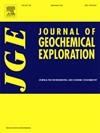Magmatic and hydrothermal evolution of the Weilasituo Sn polymetallic deposit recorded by the Li and O isotope compositions of zinnwaldite
IF 3.3
2区 地球科学
Q1 GEOCHEMISTRY & GEOPHYSICS
引用次数: 0
Abstract
Lithium and O isotopic compositions of zinnwaldite from magmatic (cassiterite), magmatic-hydrothermal transition (UST) and hydrothermal (tin‑tungsten, molybdenum and copper‑zinc) stages of the Weilasituo Sn polymetallic deposit and fluid inclusions in quartz are used to trace the magmatic-hydrothermal evolution. Fluid inclusion microthermometry and laser Raman analysis indicate that the H2O-NaCl-CO2-CH4 fluids associated with the Weilasituo deposit have high to medium-high temperatures and moderate salinities. The δ7Li values of magmatic zinnwaldite decrease with magmatic differentiation, which cannot be explained by fractional crystallization alone and, therefore, reflect late-stage fluid exsolution. Lithium and O isotope fractionation during fluid evolution depends not only on the temperature, but also on fluid-rock reactions that affect the Li and O isotopic compositions of the fluids from the hydrothermal tin‑tungsten stage and liquid-vapor phase separations that decrease δ7Li and increase δ18O of the fluids from the copper‑zinc stage.
锡walwalite Li、O同位素组成记录的魏拉斯沱锡多金属矿床岩浆和热液演化
利用魏拉斯托锡多金属矿床岩浆(锡石)、岩浆-热液过渡(UST)和热液(锡-钨、钼和铜-锌)阶段锌walite的锂和O同位素组成以及石英中的流体包裹体,对其岩浆-热液演化进行了追踪。流体包裹体显微测温和激光拉曼分析表明,与魏拉斯沱矿床相关的H2O-NaCl-CO2-CH4流体具有高至中高温、中等盐度的特征。岩浆锌walite的δ7Li值随岩浆分异而减小,不能单独用分异结晶来解释,反映了后期流体的析出作用。流体演化过程中锂、氧同位素分馏不仅取决于温度,还取决于影响热液锡钨阶段流体Li、O同位素组成的流-岩反应,以及影响铜锌阶段流体δ7Li降低、δ18O增加的液-气相分离。
本文章由计算机程序翻译,如有差异,请以英文原文为准。
求助全文
约1分钟内获得全文
求助全文
来源期刊

Journal of Geochemical Exploration
地学-地球化学与地球物理
CiteScore
7.40
自引率
7.70%
发文量
148
审稿时长
8.1 months
期刊介绍:
Journal of Geochemical Exploration is mostly dedicated to publication of original studies in exploration and environmental geochemistry and related topics.
Contributions considered of prevalent interest for the journal include researches based on the application of innovative methods to:
define the genesis and the evolution of mineral deposits including transfer of elements in large-scale mineralized areas.
analyze complex systems at the boundaries between bio-geochemistry, metal transport and mineral accumulation.
evaluate effects of historical mining activities on the surface environment.
trace pollutant sources and define their fate and transport models in the near-surface and surface environments involving solid, fluid and aerial matrices.
assess and quantify natural and technogenic radioactivity in the environment.
determine geochemical anomalies and set baseline reference values using compositional data analysis, multivariate statistics and geo-spatial analysis.
assess the impacts of anthropogenic contamination on ecosystems and human health at local and regional scale to prioritize and classify risks through deterministic and stochastic approaches.
Papers dedicated to the presentation of newly developed methods in analytical geochemistry to be applied in the field or in laboratory are also within the topics of interest for the journal.
 求助内容:
求助内容: 应助结果提醒方式:
应助结果提醒方式:


